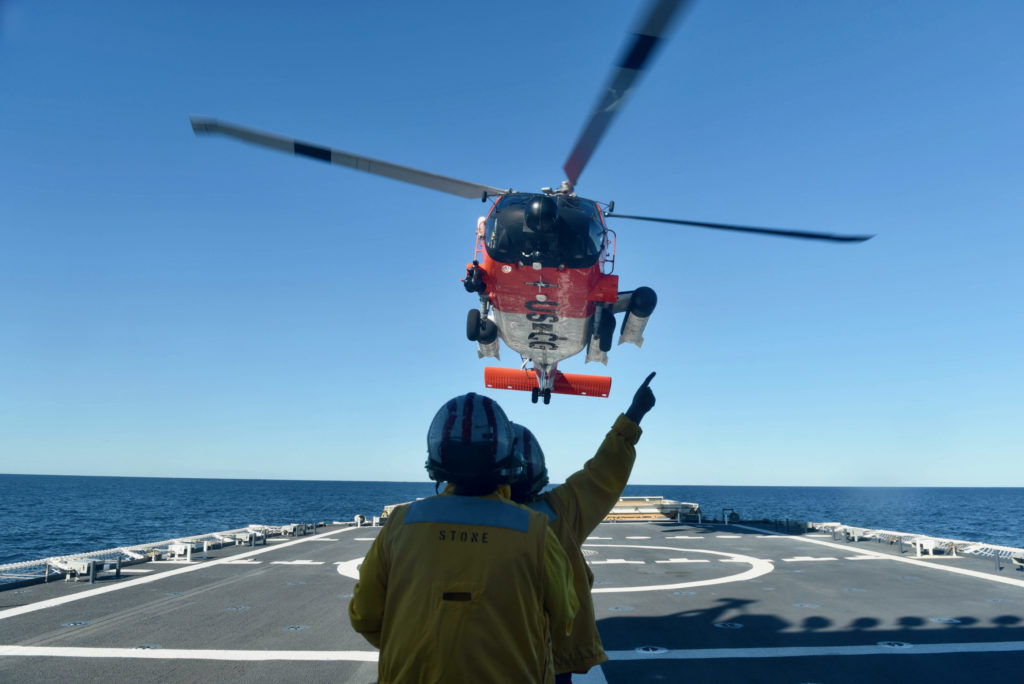Foldable MH-60T Jayhawk helicopters, suitable for stowing aboard seagoing U.S. Coast Guard cutters, will lengthen the operational reach of those ships and eventually become the standard aviation platform for deployed vessels, according to the service’s highest-ranking officer.
The Coast Guard is in the process of boosting its fleet of larger Jayhawks while reducing the number of smaller MH-65 Dolphin helicopters and tasking the remaining fleets to missions that suit their respective capacities and range, according to Commandant Adm. Karl Schultz.

“I see the future of the Coast Guard is going to be shipboard, deployed rotary-wing aviation capability,” Schultz said March 11, during his annual State of the Coast Guard address.
Where an MH-65 has about 90 minutes of mission flight time, an MH-60T can stay in the air more than four hours, Schultz said.
“It’s a more powerful, capable aircraft,” he said during the speech, delivered at Coast Guard Sector San Diego in California. “Not to diminish what our Dolphin helicopters are doing, but I think it increases the bubble around our ship, the ability to be effective.”
Schultz praised the Dolphin as “tremendous” but said they are difficult to maintain and spare parts are scarce now that the MH-65, initially built by Aérospatiale Helicopter Corporation, then Eurocopter (now Airbus Helicopters) are no longer in production.
“They don’t build them anymore, so when you stop building things you start to think about parts from a longevity standpoint,” Schultz said.
There are 98 MH-65s in the Coast Guard’s inventory and about 45 MH-60Ts. Plans are to reduce the number of Dolphins while increasing the number of Jayhawks in operation, Schultz said. That will be accomplished by taking over operation of Navy MH-60 Seahawks when they have about 8,000-9,000 hours on them, then refurbishing and reconfiguring them to Coast Guard specs. The Coast Guard then plans to put another 20,000 flight hours on the MH-60Ts, he said.
“Two weeks ago, in Elizabeth City, North Carolina, I observed our first MH-60 Tango Jayhawk outfitted with blade-fold/tail-fold capability that will enable deployment aboard National Security Cutters, and our future Polar Security and Offshore Patrol cutters,” Schultz said. “Looking across our two rotary-wing fleets, we find the Jayhawk has a robust domestic industrial base that can help buy down our operating risk in the decade ahead.”
The Coast Guard deploys the smaller MH-65D/E Dolphin helicopters on its larger National Security and High Endurance cutters. Those ships and the new Polar Security Cutters likely will carry Jayhawks to sea on future deployments beyond 2022, while the Dolphin will remain the baseline aviation platform for smaller coastal ships that require less operational reach, Schultz said.

A Polar Security Cutter is likely the first vessel where an MH-60T will be deployed as the baseline aviation capability, in order to lengthen the ship’s reach at the remote ends of the earth, Schultz said.
“Polar security cutters, when you think about the distance they operate, that extra three-four hours of operating parameter, that would serve itself well when you get down to Antarctica,” which the Coast Guard did in 2019 to perform treaty inspection for the first time in more than 20 years, Schultz said.
“An MH-60 Tango down there, that would really expand our reach,” he added.
Within the next 18 months, the Coast Guard should have ironed out a proof-of-concept for deploying Jayhawks aboard some of its cutters, Schultz said. The engineering work on the first folding MH-60T was just completed in Elizabeth City.
There are no plans to retire the MH-65 completely. Some of the fleet are undergoing service life extension and capability upgrades. In support of U.S. Northern Command and NORAD, the Coast Guard has begun installing Link 16 communication equipment aboard Dolphin helicopters stationed at the National Capital Regional Air Defense Facility.
“This tactical datalink will better link our aircraft that perform this important capital region mission,” Schultz said.
“I think the 98 [Dolphin fleet] comes down; maybe ultimately the mission we do around the capital for the low-and-slows . . . we probably stay in that game,” Schultz said. MH-65s also will “probably stay in the [Helicopter Interdiction Tactical Squadron] HITRON at sea . . . the counter-drug missions that shoots out the engines [of suspected smuggling vessels]. That probably stays a Dolphin mission for a while.”
Meanwhile, the Coast Guard continues to transition its land bases from the Dolphin to the Jayhawks, increasing its offshore patrol as search-and-rescue range. In 2021, the aviation unit at Air Station Borinquen in Puerto Rico will replace its MH-65s with MH-60Ts, which will add “additional reach and contingency response capability to the eastern Caribbean, not to mention a likely land-based aviation use-of-force capability,” Schultz said. “Air Station New Orleans will be the next to transition.”









